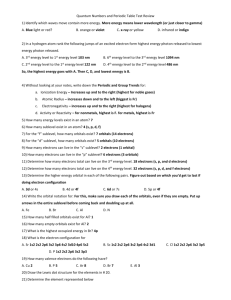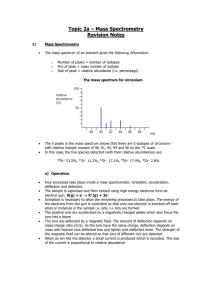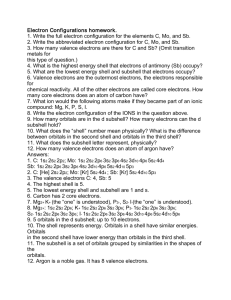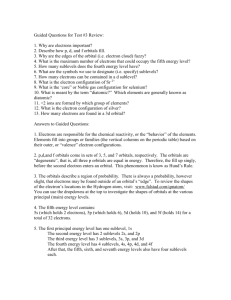Chemistry: Chapter 5 Review
advertisement
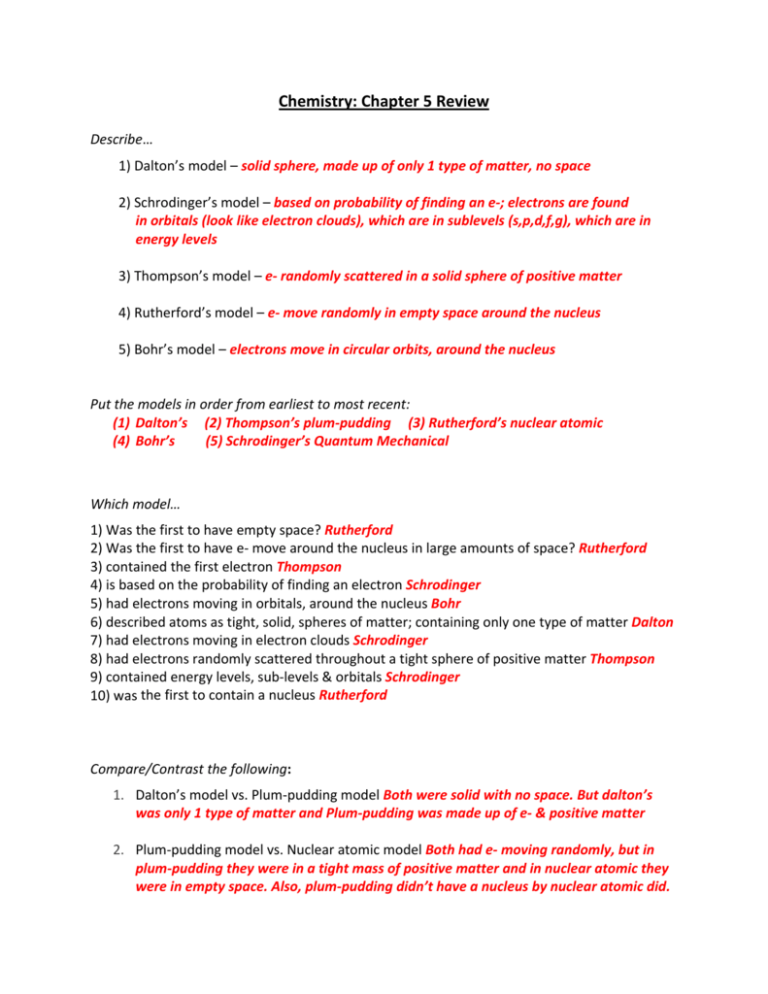
Chemistry: Chapter 5 Review Describe… 1) Dalton’s model – solid sphere, made up of only 1 type of matter, no space 2) Schrodinger’s model – based on probability of finding an e‐; electrons are found in orbitals (look like electron clouds), which are in sublevels (s,p,d,f,g), which are in energy levels 3) Thompson’s model – e‐ randomly scattered in a solid sphere of positive matter 4) Rutherford’s model – e‐ move randomly in empty space around the nucleus 5) Bohr’s model – electrons move in circular orbits, around the nucleus Put the models in order from earliest to most recent: (1) Dalton’s (2) Thompson’s plum‐pudding (3) Rutherford’s nuclear atomic (4) Bohr’s (5) Schrodinger’s Quantum Mechanical Which model… 1) Was the first to have empty space? Rutherford 2) Was the first to have e‐ move around the nucleus in large amounts of space? Rutherford 3) contained the first electron Thompson 4) is based on the probability of finding an electron Schrodinger 5) had electrons moving in orbitals, around the nucleus Bohr 6) described atoms as tight, solid, spheres of matter; containing only one type of matter Dalton 7) had electrons moving in electron clouds Schrodinger 8) had electrons randomly scattered throughout a tight sphere of positive matter Thompson 9) contained energy levels, sub‐levels & orbitals Schrodinger 10) was the first to contain a nucleus Rutherford Compare/Contrast the following: 1. Dalton’s model vs. Plum‐pudding model Both were solid with no space. But dalton’s was only 1 type of matter and Plum‐pudding was made up of e‐ & positive matter 2. Plum‐pudding model vs. Nuclear atomic model Both had e‐ moving randomly, but in plum‐pudding they were in a tight mass of positive matter and in nuclear atomic they were in empty space. Also, plum‐pudding didn’t have a nucleus by nuclear atomic did. 3. Nuclear atomic model vs. Bohr’s model Both had e‐ moving around the nucleus, but nuclear atomic had them moving randomly and Bohr’s had them moving in orbitals. Answer the following about the Quantum Mechanical Model… 1) What are the sublevels contained within fourth energy level? 4s, 4p, 4d, 4f 2) What is the maximum number of electrons can be found in the 3s sublevel? 2, b/c all s’s have 1 orbital 3) How many orbitals are in the 3p sublevel? 3, b/c all p’s have 3 orbitals 4) Theoretically, how many sublevels would be in the 9th energy level? 9, b/c the # of sublevels is always the same as the energy level 5) How many orbitals can be found in the 2nd energy level? 4, b/c the formula is n2 also, the 2nd energy level has an s (1 orbital) & p (3 orbitals) and 1 + 3 = 4 6) How many orbitals are in the 3d sublevel? 5, b/c all d’s have 5 orbitals 7) How many electrons can fit in each orbital? 2, it’s a rule (memorize it) 8) What is the maximum number of electrons can be found in the 2p sublevel? 6, b/c p’s have 3 orbitals and 2 e‐ can fit in each 9) How many orbitals would be in n = 6? 36, b/c the formula is n2 10) How many electrons would be in n=6? 72, b/c the formula is 2n2 11) How many orbitals are in the 1s sublevel? 1, b/c all s’s have 1 orbital 12) How many sublevels are in n = 2? 2, b/c the # of sublevels is always the same as the energy level 13) What is the maximum number of electrons can be found in the 4f sublevel? 14, b/c f’s have 7 orbitals, and 2 e‐ can fit in each 14) How many electrons can fit in the third energy level? 18, the formula is 2n2 15) How many orbitals are in the 5f sublevel? 7, b/c all f’s have 7 orbitals 16) What is the maximum number of electrons can be found in the 5d sublevel? 10, b/c all d’s have 5 orbitals which can fit 2 e‐ each 17) Compare & contrast a 1s, 2s and 2p orbital without drawing them. 1s & 2s are the same shape (sphere), but 2p is different (“snowman”) 1s will be smaller, but 2s and 2p will have the same size 18) How many orbitals are in the 2p sublevel? 3, b/c all p’s have 3 orbitals 19) Circle which of the following do NOT exist: 2p 4d 1s 2d 3s 3f 1p 4f 5d Describe each rule: 1) Aufbau – electrons fill the lowest available sub‐level first; Aufbau gives the order we fill the sublevels 2) Pauli exclusion – electrons in the same orbital will have opposite spins (1up/1down); each orbital (line) will have an up and a down arrow 3) Hund’s – maximum # of electrons, in a sublevel, with the same spin (fill all up’s before filling any downs) Draw & Write an electron configuration for… 1. Beryllium 1s2, 2s2 (drawn ends w/ 2 e‐ in 2s) 2. Carbon 1s2, 2s2, 2p2 (drawn ends w/ 2 up e‐ in 2p) 3. Potassium 1s2, 2s2, 2p6, 3s2, 3p6, 4s1 (drawn ends w/ 1 up e‐ in 4s) 4. Titanium 1s2, 2s2, 2p6, 3s2, 3p6, 4s2, 3d2 (drawn ends w/ 2 up in 3d & 3 blank) 5. Lead 1s2, 2s2, 2p6, 3s2, 3p6, 4s2, 3d10, 4p6, 5s2,4d10, 5p6, 6s2,5d10,6p2 (ends w/ 2 up in 6p) 6. Helium 1s2 (drawn ends w/ 2 e‐ in 1s) 7. Nitrogen 1s2, 2s2, 2p3 (drawn ends w/ 3 up e‐ in 2p) 8. Chlorine 1s2, 2s2, 2p6, 3s2, 3p5 (drawn ends w/ 5 e‐, 3 up, 2 down, in 3p) 9. Iron 1s2, 2s2, 2p6, 3s2, 3p6, 4s2, 3d6 (drawn ends w/ 6 e‐, 5 up, 1 down, in 3d) 10. Zinc 1s2, 2s2, 2p6, 3s2, 3p6, 4s2, 3d10 (drawn ends w/ 10 e‐ in 3d) Define: Amplitude – distance from zero to crest Frequency – measures how close together cycles are Wavelength – distance from crest to crest Crest – highest or lowest point on a wave Wave cycle – a full up and down cycle Hertz – unit for frequency Electromagnetic radiation – describes all types of light, heat and energy What is the relationship between… wavelength and frequency? High frequency has a short wavelength; low frequency has a long wavelength energy and frequency? High energy has a high frequency; low energy has a low frequency wavelength and energy? Long wavelength has low energy; short wavelength has a high energy List the 7 types of electromagnetic radiation (include all colors of visible light) from: Low frequency → high frequency Radio, Microwave, InfraRed, Visible (R‐O‐Y‐G‐B‐I‐V), UltraViolet, Xray, Gamma Low energy → high energy Radio, Microwave, InfraRed, Visible (R‐O‐Y‐G‐B‐I‐V), UltraViolet, Xray, Gamma Short wavelength → long wavelength Gamma, Xray, UltraViolet, Visible (V‐I‐B‐G‐Y‐O‐R), InfraRed, Microwave, Radio Consider the following: an e‐ which moved from n=4 to 1 and an e‐ which moved from n=3 to 2 Which gives off electromagnetic radiation of a higher energy? n=4 to 1 Which gives off electromagnetic radiation of a longer wavelength? n=3 to 2 Which gives off electromagnetic radiation of a higher frequency? n=4 to 1

